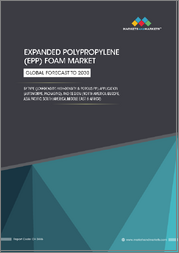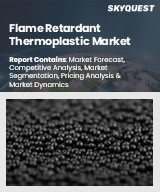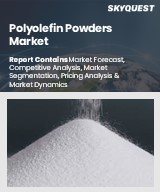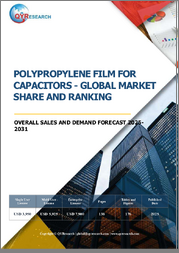
|
시장보고서
상품코드
1618694
세계의 변성 폴리프로필렌 시장 : 유형별, 가공 기술별, 용도별 예측(2025-2030년)Modified Polypropylene Market by Type (Flame Retardant Polypropylene, Glass Fiber-Filled Polypropylene, Impact-Modified Polypropylene), Processing Technology (Compounding, Copolymerization, Reinforcement), Application - Global Forecast 2025-2030 |
||||||
변성 폴리프로필렌 시장의 2023년 시장 규모는 367억 달러로 평가되었습니다. 2024년에는 385억 2,000만 달러에 달할 것으로 예측되며, CAGR 5.11%로 성장하고, 2030년에는 520억 5,000만 달러에 도달할 것으로 예측됩니다.
변성 폴리프로필렌이란 화학적 또는 물리적으로 변화시켜 강도, 유연성, 내열성 등의 특성을 향상시킨 폴리프로필렌을 말합니다. 섬유, 건축 빌딩 등 다양한 산업에 걸친 광범위한 용도에서 발생하고 있습니다.
| 주요 시장 통계 | |
|---|---|
| 기준년(2023) | 367억 달러 |
| 추정년(2024) | 385억 2,000만 달러 |
| 예측년(2030) | 520억 5,000만 달러 |
| CAGR(%) | 5.11% |
변성 폴리프로필렌 시장은 경량이고 고성능인 소재에 대한 수요 증가에 영향을 받고 있습니다. 에너지 도입과 소비재 포장의 선진화도 시장 성장을 뒷받침하고 있습니다. 재활용 가능한 소재에 대한 요구 증가가 바이오 충전재나 바이오 복합재 등 폴리프로필렌의 환경 친화적인 개량을 위한 기술 혁신을 뒷받침하고 있는 것도 큰 비즈니스 기회입니다. 이를 위해 기업은 고성능, 친환경 폴리프로필렌의 R&D에 투자해야 합니다.
그러나 주로 원유에 대한 의존으로 인한 원료 가격의 변동이 시장 성장의 큰 제약이되고 있습니다. 이러한 과제에도 불구하고 기술 혁신 분야에는 변성 폴리프로필렌의 재활용성 향상, 바이오 폴리프로필렌 복합재료 개발, 첨단 응용을 위한 다른 재료와의 호환성 향상 등이 포함됩니다.
종합하면 변성 폴리프로필렌 시장은 다양한 산업에서 고성능 경량 재료 수요로 인해 큰 성장 기회를 가져오고 있습니다. 새롭고 친환경적인 개선과 재활용성 강화에 주력하는 기업은 경쟁 우위를 차지할 수 있습니다. 지속적인 진보를 선호하는 것이 좋습니다.
시장 역학: 급속히 진화하는 변성 폴리프로필렌 시장의 주요 시장 인사이트 공개
변성 폴리프로필렌 시장은 수요 및 공급의 역동적인 상호작용에 의해 변모를 이루고 있습니다. 그리고 새로운 비즈니스 기회 획득에 대비하는 것 이러한 동향을 종합적으로 파악함으로써 기업은 정치적, 지리적, 기술적, 사회적, 경제적 영역에 걸친 다양한 위험을 완화할 수 있으며, 또한 소비자 행동 그리고 그것이 제조 비용과 구매 동향에 미치는 영향을보다 명확하게 이해할 수 있습니다.
- 시장 성장 촉진요인
- 자동차 및 포장 업계로부터 수요 증가
- 자동차 경량화와 연비 향상을 위한 플라스틱 사용 증가
- 바이오 베이스로 리사이클 가능한 폴리프로필렌의 인기가 높아져
- 시장 성장 억제요인
- 원료 가격의 변동
- 시장 기회
- 제조용 첨가제나 충전제의 지속적인 진보 변성 폴리프로필렌
- 정부에 의한 스마트 시티, 공항, 상업 빌딩 건설 투자 증가
- 시장의 과제
- 플라스틱의 사용에 관한 엄격한 규제 환경
Porter's Five Force : 변성 폴리프로필렌 시장을 탐색하는 전략 도구
Porter's Five Force Framework는 시장 상황경쟁 구도를 이해하는 중요한 도구입니다. 기업이 시장 내 세력도를 평가하고 신규 사업의 수익성을 판단하는 데 도움이 됩니다. 당신은 더 강인한 시장에서 포지셔닝을 보장할 수 있습니다.
PESTLE 분석 : 변성 폴리프로필렌 시장에서 외부로부터의 영향 파악
외부 거시 환경 요인은 변성 폴리프로필렌 시장의 성과 역학을 형성하는 데 매우 중요한 역할을합니다. PESTLE 요인을 조사하면 기업은 잠재적인 위험과 기회를 더 잘 이해할 수 있습니다. 적극적인 의사 결정을 할 준비가되어 있습니다.
시장 점유율 분석 : 변성 폴리 프로필렌 시장 경쟁 구도 파악
변성 폴리프로필렌 시장의 상세한 시장 점유율 분석을 통해 공급업체의 성과를 종합적으로 평가할 수 있습니다. 이 분석은 시장 집중, 단편화 및 통합 동향을 명확히하고 벤더는 경쟁이 치열 해짐에 따라 자사의 지위를 높이는 전략적 의사 결정을 내리는 데 필요합니다.
FPNV 포지셔닝 매트릭스 : 변성 폴리프로필렌 시장에서 공급업체의 성능 평가
FPNV 포지셔닝 매트릭스는 변성 폴리프로필렌 시장에서 벤더를 평가하는 중요한 도구입니다. 기본 결정을 내릴 수 있습니다. 네 가지 사분면을 통해 벤더를 명확하고 정확하게 분류하고 전략 목표에 가장 적합한 파트너 및 솔루션을 파악할 수 있습니다.
전략 분석 및 권장 : 변성 폴리프로필렌 시장에서 성공을 위한 길을 그리기
변성 폴리프로필렌 시장의 전략 분석은 세계 시장에서의 프레즌스 강화를 목표로 하는 기업에 필수적입니다. 이 접근법을 통해 경쟁 구도에서 과제를 극복하고 새로운 비즈니스 기회를 활용하여 장기적인 성공을 거둘 수 있는 체제를 구축할 수 있습니다.
이 보고서는 주요 관심 분야를 포괄하는 시장의 종합적인 분석을 제공합니다.
1. 시장 침투: 현재 시장 환경의 상세한 검토, 주요 기업의 광범위한 데이터, 시장 도달범위 및 전반적인 영향력 평가.
2. 시장 개척도: 신흥 시장의 성장 기회를 파악하고, 기존 분야의 확장 가능성을 평가하고, 미래 성장을 위한 전략적 로드맵을 제공합니다.
3. 시장 다양화: 최근 제품 출시, 미개척 지역, 업계의 주요 진보, 시장을 형성하는 전략적 투자를 분석합니다.
4. 경쟁 평가 및 정보 : 경쟁 구도를 철저히 분석하여 시장 점유율, 사업 전략, 제품 포트폴리오, 인증, 규제 당국 승인, 특허 동향, 주요 기업의 기술 진보 등을 검증합니다.
5. 제품 개발 및 혁신 : 미래 시장 성장을 가속할 것으로 예상되는 최첨단 기술, R&D 활동, 제품 혁신을 강조합니다.
또한 이해관계자가 충분한 정보를 얻고 의사결정을 할 수 있도록 중요한 질문에 대답하고 있습니다.
1. 현재 시장 규모와 향후 성장 예측은?
2. 최고의 투자 기회를 제공하는 제품, 부문 및 지역은 어디입니까?
3. 시장을 형성하는 주요 기술 동향과 규제의 영향은?
4. 주요 벤더의 시장 점유율과 경쟁 포지션은?
5. 벤더 시장 진입·철수 전략의 원동력이 되는 수익원과 전략적 기회는 무엇인가?
목차
제1장 서문
제2장 조사 방법
제3장 주요 요약
제4장 시장 개요
제5장 시장 인사이트
- 시장 역학
- 성장 촉진요인
- 자동차·포장 업계로부터 수요 증가
- 차량 중량의 경감과 연비 향상을 위해 플라스틱의 사용이 증가
- 바이오 베이스로 리사이클 가능한 폴리프로필렌의 인기가 높아지고 있다
- 억제요인
- 원재료 가격 변동
- 기회
- 제조용 첨가제와 충전제의 지속적인 진보 변성 폴리프로필렌
- 정부에 의한 스마트 시티, 공항, 상업 빌딩 건설 투자 증가
- 과제
- 플라스틱의 사용에 관한 엄격한 규제 환경
- 성장 촉진요인
- 시장 세분화 분석
- 유형 : 유리 섬유가 들어있는 폴리 프로필렌은 뛰어난 강도와 열 성능으로 최종 사용자에게 선호됩니다.
- 용도 : 개질 프로필렌의 특수한 요구와 내구성에 의해 자동차 및 건설 부문으로부터의 큰 수요가 있습니다.
- Porter's Five Forces 분석
- PESTEL 분석
- 정치적
- 경제
- 사교
- 기술적
- 법률상
- 환경
제6장 변성 폴리프로필렌 시장 : 유형별
- 난연성 폴리프로필렌
- 유리 섬유 함유 폴리프로필렌
- 내충격성 폴리프로필렌
- 탈크 함유 폴리 프로필렌
제7장 변성 폴리프로필렌 시장 : 가공 기술별
- 복리
- 공중합
- 강화
제8장 변성 폴리프로필렌 시장 : 용도별
- 자동차
- 건축 및 건설
- 전기 및 전자
- 의학
- 패키지
제9장 아메리카의 변성 폴리프로필렌 시장
- 아르헨티나
- 브라질
- 캐나다
- 멕시코
- 미국
제10장 아시아태평양의 변성 폴리프로필렌 시장
- 호주
- 중국
- 인도
- 인도네시아
- 일본
- 말레이시아
- 필리핀
- 싱가포르
- 한국
- 대만
- 태국
- 베트남
제11장 유럽·중동 및 아프리카의 변성 폴리프로필렌 시장
- 덴마크
- 이집트
- 핀란드
- 프랑스
- 독일
- 이스라엘
- 이탈리아
- 네덜란드
- 나이지리아
- 노르웨이
- 폴란드
- 카타르
- 러시아
- 사우디아라비아
- 남아프리카
- 스페인
- 스웨덴
- 스위스
- 터키
- 아랍에미리트(UAE)
- 영국
제12장 경쟁 구도
- 시장 점유율 분석 2023
- FPNV 포지셔닝 매트릭스, 2023
- 경쟁 시나리오 분석
- LOTTE Chemical, 재활용 난연 PP 소재 개발
- SABIC, 자동차 구조 용도를 위한 성능을 강화한 새로운 단유리 섬유 충전 PP 컴파운드를 발매
- INEOS와 NEXTLOOPP가 폴리프로필렌의 재활용에 협력
- 전략 분석과 제안
기업 목록
- Arkema SA
- Asahi Kasei Corporation
- Axion Polymers
- BASF SE
- Celanese Corporation
- Covestro AG
- Exxon Mobil Corporation
- Fuzhou Topda New Material Co., Ltd.
- Hanwha Group
- HMC Polymers Co., Ltd.
- INEOS AG
- Kingfa Science & Technology(India)Limited
- Kraton Corporation
- LCY GROUP
- LG Chem Ltd.
- Lotte Chemical Corporation
- LyondellBasell Industries Holdings BV
- Mitsui Chemicals, Inc.
- Poly Pacific Pty. Ltd.
- RTP Company
- Saudi Basic Industries Corporation
- The Dow Chemical Company
- Westlake Corporation
- Xiamen Keyuan Plastic Co.,Ltd
- Xiamen LFT Composite Plastic Co.,Ltd
The Modified Polypropylene Market was valued at USD 36.70 billion in 2023, expected to reach USD 38.52 billion in 2024, and is projected to grow at a CAGR of 5.11%, to USD 52.05 billion by 2030.
Modified polypropylene refers to polypropylene that has been chemically or physically altered to enhance its properties, such as increased strength, flexibility, or thermal resistance. The necessity of modified polypropylene arises from its extensive applications across diverse industries, including automotive, packaging, textiles, and construction, where enhanced material performance is critical. The end-use scope is vast, covering components in automotive manufacturing such as bumpers and interior trim, packaging materials that require a higher barrier resistance, and construction products needing improved durability.
| KEY MARKET STATISTICS | |
|---|---|
| Base Year [2023] | USD 36.70 billion |
| Estimated Year [2024] | USD 38.52 billion |
| Forecast Year [2030] | USD 52.05 billion |
| CAGR (%) | 5.11% |
The modified polypropylene market is influenced by the growing demand for lightweight and high-performance materials, particularly in the automotive sector where reducing vehicle weight is crucial for enhancing fuel efficiency and meeting stringent environmental regulations. Renewable energy installations and advancements in consumer goods packaging also propel market growth. A significant opportunity lies in the increasing need for sustainable and recyclable materials, pushing innovation toward eco-friendly modifications of polypropylene, such as bio-fillers and biocomposites. To capitalize on these opportunities, companies should invest in research and development for creating high-performance and environmentally friendly modified polypropylene variants.
However, market growth is challenged by fluctuating raw material prices, mainly due to the dependence on crude oil, which poses a significant limitation. Additionally, environmental concerns related to plastic waste management and recycling effectiveness hinder market expansion. Despite these challenges, innovation areas include enhancing the recyclability of modified polypropylene, developing bio-based polypropylene composites, and improving compatibility with other materials for advanced applications.
In summary, the modified polypropylene market presents significant growth opportunities driven by demand for high-performance, lightweight materials across various industries. Addressing the challenges posed by raw material volatility and environmental sustainability will be crucial. Companies focusing on innovative, eco-friendly modifications and enhancing recyclability stand to gain a competitive edge. Consequently, market players are encouraged to prioritize sustainable practices and continuous advancement in polymer technology for long-term business growth.
Market Dynamics: Unveiling Key Market Insights in the Rapidly Evolving Modified Polypropylene Market
The Modified Polypropylene Market is undergoing transformative changes driven by a dynamic interplay of supply and demand factors. Understanding these evolving market dynamics prepares business organizations to make informed investment decisions, refine strategic decisions, and seize new opportunities. By gaining a comprehensive view of these trends, business organizations can mitigate various risks across political, geographic, technical, social, and economic domains while also gaining a clearer understanding of consumer behavior and its impact on manufacturing costs and purchasing trends.
- Market Drivers
- Expanding demand from the automotive and packaging industry
- Rising use of plastics to reduce vehicle weight and enhance fuel economy
- Growing popularity of bio-based and recyclable polypropylene
- Market Restraints
- Fluctuations in prices of raw materials
- Market Opportunities
- Ongoing advancements in additives and fillers for manufacturing modified polypropylene
- Increasing investments in the building of smart cities, airports, and commercial buildings by governments
- Market Challenges
- Stringent regulatory environment concerning the use of plastics
Porter's Five Forces: A Strategic Tool for Navigating the Modified Polypropylene Market
Porter's five forces framework is a critical tool for understanding the competitive landscape of the Modified Polypropylene Market. It offers business organizations with a clear methodology for evaluating their competitive positioning and exploring strategic opportunities. This framework helps businesses assess the power dynamics within the market and determine the profitability of new ventures. With these insights, business organizations can leverage their strengths, address weaknesses, and avoid potential challenges, ensuring a more resilient market positioning.
PESTLE Analysis: Navigating External Influences in the Modified Polypropylene Market
External macro-environmental factors play a pivotal role in shaping the performance dynamics of the Modified Polypropylene Market. Political, Economic, Social, Technological, Legal, and Environmental factors analysis provides the necessary information to navigate these influences. By examining PESTLE factors, businesses can better understand potential risks and opportunities. This analysis enables business organizations to anticipate changes in regulations, consumer preferences, and economic trends, ensuring they are prepared to make proactive, forward-thinking decisions.
Market Share Analysis: Understanding the Competitive Landscape in the Modified Polypropylene Market
A detailed market share analysis in the Modified Polypropylene Market provides a comprehensive assessment of vendors' performance. Companies can identify their competitive positioning by comparing key metrics, including revenue, customer base, and growth rates. This analysis highlights market concentration, fragmentation, and trends in consolidation, offering vendors the insights required to make strategic decisions that enhance their position in an increasingly competitive landscape.
FPNV Positioning Matrix: Evaluating Vendors' Performance in the Modified Polypropylene Market
The Forefront, Pathfinder, Niche, Vital (FPNV) Positioning Matrix is a critical tool for evaluating vendors within the Modified Polypropylene Market. This matrix enables business organizations to make well-informed decisions that align with their goals by assessing vendors based on their business strategy and product satisfaction. The four quadrants provide a clear and precise segmentation of vendors, helping users identify the right partners and solutions that best fit their strategic objectives.
Strategy Analysis & Recommendation: Charting a Path to Success in the Modified Polypropylene Market
A strategic analysis of the Modified Polypropylene Market is essential for businesses looking to strengthen their global market presence. By reviewing key resources, capabilities, and performance indicators, business organizations can identify growth opportunities and work toward improvement. This approach helps businesses navigate challenges in the competitive landscape and ensures they are well-positioned to capitalize on newer opportunities and drive long-term success.
Key Company Profiles
The report delves into recent significant developments in the Modified Polypropylene Market, highlighting leading vendors and their innovative profiles. These include Arkema SA, Asahi Kasei Corporation, Axion Polymers, BASF SE, Celanese Corporation, Covestro AG, Exxon Mobil Corporation, Fuzhou Topda New Material Co., Ltd., Hanwha Group, HMC Polymers Co., Ltd., INEOS AG, Kingfa Science & Technology (India) Limited, Kraton Corporation, LCY GROUP, LG Chem Ltd., Lotte Chemical Corporation, LyondellBasell Industries Holdings B.V., Mitsui Chemicals, Inc., Poly Pacific Pty. Ltd., RTP Company, Saudi Basic Industries Corporation, The Dow Chemical Company, Westlake Corporation, Xiamen Keyuan Plastic Co.,Ltd, and Xiamen LFT Composite Plastic Co.,Ltd.
Market Segmentation & Coverage
This research report categorizes the Modified Polypropylene Market to forecast the revenues and analyze trends in each of the following sub-markets:
- Based on Type, market is studied across Flame Retardant Polypropylene, Glass Fiber-Filled Polypropylene, Impact-Modified Polypropylene, and Talc-Filled Polypropylene.
- Based on Processing Technology, market is studied across Compounding, Copolymerization, and Reinforcement.
- Based on Application, market is studied across Automotive, Building & Construction, Electrical & Electronics, Medical, and Packaging.
- Based on Region, market is studied across Americas, Asia-Pacific, and Europe, Middle East & Africa. The Americas is further studied across Argentina, Brazil, Canada, Mexico, and United States. The United States is further studied across California, Florida, Illinois, New York, Ohio, Pennsylvania, and Texas. The Asia-Pacific is further studied across Australia, China, India, Indonesia, Japan, Malaysia, Philippines, Singapore, South Korea, Taiwan, Thailand, and Vietnam. The Europe, Middle East & Africa is further studied across Denmark, Egypt, Finland, France, Germany, Israel, Italy, Netherlands, Nigeria, Norway, Poland, Qatar, Russia, Saudi Arabia, South Africa, Spain, Sweden, Switzerland, Turkey, United Arab Emirates, and United Kingdom.
The report offers a comprehensive analysis of the market, covering key focus areas:
1. Market Penetration: A detailed review of the current market environment, including extensive data from top industry players, evaluating their market reach and overall influence.
2. Market Development: Identifies growth opportunities in emerging markets and assesses expansion potential in established sectors, providing a strategic roadmap for future growth.
3. Market Diversification: Analyzes recent product launches, untapped geographic regions, major industry advancements, and strategic investments reshaping the market.
4. Competitive Assessment & Intelligence: Provides a thorough analysis of the competitive landscape, examining market share, business strategies, product portfolios, certifications, regulatory approvals, patent trends, and technological advancements of key players.
5. Product Development & Innovation: Highlights cutting-edge technologies, R&D activities, and product innovations expected to drive future market growth.
The report also answers critical questions to aid stakeholders in making informed decisions:
1. What is the current market size, and what is the forecasted growth?
2. Which products, segments, and regions offer the best investment opportunities?
3. What are the key technology trends and regulatory influences shaping the market?
4. How do leading vendors rank in terms of market share and competitive positioning?
5. What revenue sources and strategic opportunities drive vendors' market entry or exit strategies?
Table of Contents
1. Preface
- 1.1. Objectives of the Study
- 1.2. Market Segmentation & Coverage
- 1.3. Years Considered for the Study
- 1.4. Currency & Pricing
- 1.5. Language
- 1.6. Stakeholders
2. Research Methodology
- 2.1. Define: Research Objective
- 2.2. Determine: Research Design
- 2.3. Prepare: Research Instrument
- 2.4. Collect: Data Source
- 2.5. Analyze: Data Interpretation
- 2.6. Formulate: Data Verification
- 2.7. Publish: Research Report
- 2.8. Repeat: Report Update
3. Executive Summary
4. Market Overview
5. Market Insights
- 5.1. Market Dynamics
- 5.1.1. Drivers
- 5.1.1.1. Expanding demand from the automotive and packaging industry
- 5.1.1.2. Rising use of plastics to reduce vehicle weight and enhance fuel economy
- 5.1.1.3. Growing popularity of bio-based and recyclable polypropylene
- 5.1.2. Restraints
- 5.1.2.1. Fluctuations in prices of raw materials
- 5.1.3. Opportunities
- 5.1.3.1. Ongoing advancements in additives and fillers for manufacturing modified polypropylene
- 5.1.3.2. Increasing investments in the building of smart cities, airports, and commercial buildings by governments
- 5.1.4. Challenges
- 5.1.4.1. Stringent regulatory environment concerning the use of plastics
- 5.1.1. Drivers
- 5.2. Market Segmentation Analysis
- 5.2.1. Type: Glass fiber-filled polypropylene is preferred among enduser for its exceptional strength and thermal performance
- 5.2.2. Application: Massive demand from the automotive and construction sector owing to specific need and durability of modified propylene
- 5.3. Porter's Five Forces Analysis
- 5.3.1. Threat of New Entrants
- 5.3.2. Threat of Substitutes
- 5.3.3. Bargaining Power of Customers
- 5.3.4. Bargaining Power of Suppliers
- 5.3.5. Industry Rivalry
- 5.4. PESTLE Analysis
- 5.4.1. Political
- 5.4.2. Economic
- 5.4.3. Social
- 5.4.4. Technological
- 5.4.5. Legal
- 5.4.6. Environmental
6. Modified Polypropylene Market, by Type
- 6.1. Introduction
- 6.2. Flame Retardant Polypropylene
- 6.3. Glass Fiber-Filled Polypropylene
- 6.4. Impact-Modified Polypropylene
- 6.5. Talc-Filled Polypropylene
7. Modified Polypropylene Market, by Processing Technology
- 7.1. Introduction
- 7.2. Compounding
- 7.3. Copolymerization
- 7.4. Reinforcement
8. Modified Polypropylene Market, by Application
- 8.1. Introduction
- 8.2. Automotive
- 8.3. Building & Construction
- 8.4. Electrical & Electronics
- 8.5. Medical
- 8.6. Packaging
9. Americas Modified Polypropylene Market
- 9.1. Introduction
- 9.2. Argentina
- 9.3. Brazil
- 9.4. Canada
- 9.5. Mexico
- 9.6. United States
10. Asia-Pacific Modified Polypropylene Market
- 10.1. Introduction
- 10.2. Australia
- 10.3. China
- 10.4. India
- 10.5. Indonesia
- 10.6. Japan
- 10.7. Malaysia
- 10.8. Philippines
- 10.9. Singapore
- 10.10. South Korea
- 10.11. Taiwan
- 10.12. Thailand
- 10.13. Vietnam
11. Europe, Middle East & Africa Modified Polypropylene Market
- 11.1. Introduction
- 11.2. Denmark
- 11.3. Egypt
- 11.4. Finland
- 11.5. France
- 11.6. Germany
- 11.7. Israel
- 11.8. Italy
- 11.9. Netherlands
- 11.10. Nigeria
- 11.11. Norway
- 11.12. Poland
- 11.13. Qatar
- 11.14. Russia
- 11.15. Saudi Arabia
- 11.16. South Africa
- 11.17. Spain
- 11.18. Sweden
- 11.19. Switzerland
- 11.20. Turkey
- 11.21. United Arab Emirates
- 11.22. United Kingdom
12. Competitive Landscape
- 12.1. Market Share Analysis, 2023
- 12.2. FPNV Positioning Matrix, 2023
- 12.3. Competitive Scenario Analysis
- 12.3.1. LOTTE Chemical develops recycled flame-retardant PP material
- 12.3.2. Sabic Launches New Short-Glass Fiber-Filled Pp Compounds With Enhanced Performance For Automotive Structural Applications
- 12.3.3. INEOS and NEXTLOOPP Work Together To Recycle Polypropylene
- 12.4. Strategy Analysis & Recommendation
Companies Mentioned
- 1. Arkema SA
- 2. Asahi Kasei Corporation
- 3. Axion Polymers
- 4. BASF SE
- 5. Celanese Corporation
- 6. Covestro AG
- 7. Exxon Mobil Corporation
- 8. Fuzhou Topda New Material Co., Ltd.
- 9. Hanwha Group
- 10. HMC Polymers Co., Ltd.
- 11. INEOS AG
- 12. Kingfa Science & Technology (India) Limited
- 13. Kraton Corporation
- 14. LCY GROUP
- 15. LG Chem Ltd.
- 16. Lotte Chemical Corporation
- 17. LyondellBasell Industries Holdings B.V.
- 18. Mitsui Chemicals, Inc.
- 19. Poly Pacific Pty. Ltd.
- 20. RTP Company
- 21. Saudi Basic Industries Corporation
- 22. The Dow Chemical Company
- 23. Westlake Corporation
- 24. Xiamen Keyuan Plastic Co.,Ltd
- 25. Xiamen LFT Composite Plastic Co.,Ltd



















